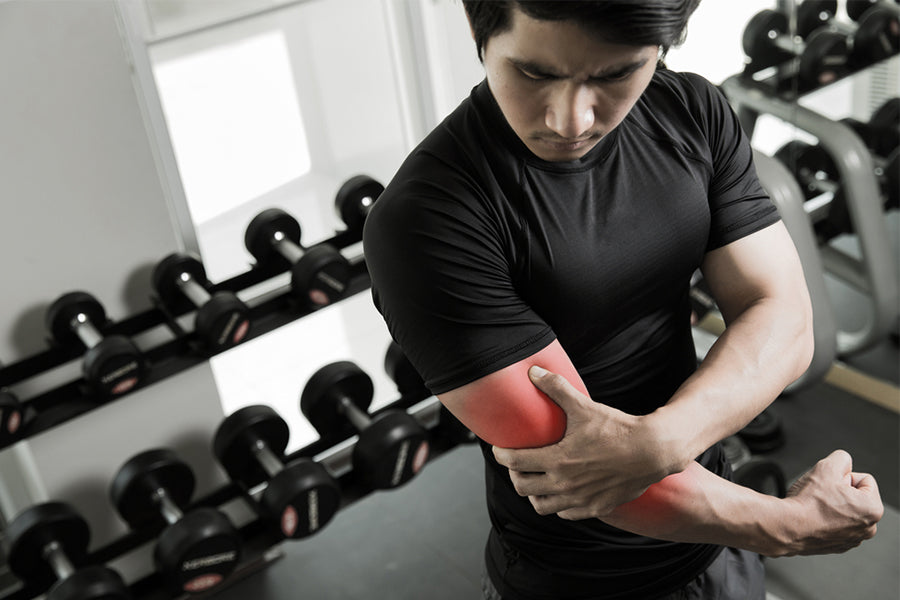It's not uncommon to experience some discomfort in your elbows from time to time. Whether a weekend warrior or a professional athlete, you've likely dealt with elbow pain or injury at some point in your life. But what exactly is causing all this pain? And why do our elbows seem to be so vulnerable to injury?
There are several reasons why elbow pain and injury occur. First, the elbow is a joint constantly moving and bearing weight, which can stress the tendons and ligaments surrounding it. Second, the bones in the elbow are relatively small and unprotected, which makes them more susceptible to fractures. And finally, the elbow joint is surrounded by several small muscles, which can quickly become overloaded and lead to pain.
While there are different methods to treat elbow pain and injuries, one is to indulge in exercising and training through a joint-by-joint approach. For that, understanding the joint-by-joint approach is a must. So let’s dig in!
Related Article: How to Cure Tennis Elbow
Joint-By-Joint Approach
The elbows are often forced to bear the brunt of your weight when you move your wrist and shoulder. For example, suppose someone has limited mobility in their shoulders. In that case, it may be necessary for them to compensate through the elbow to achieve the lift. The problem is that the elbow cannot bear the load in which the shoulder can. This can result in pain near or around where your elbow joint is located. So as you can see, this problem stems from the shoulder but is felt in the elbow, therefore, giving you a false positive without you realizing what is really wrong.
Even though you may not suffer complete pain in one area after performing these wrong movements (or perhaps only when doing specific exercises), there will likely be a point where something feels off due to a lack of stability throughout your entire body. You need a professional program for a workout that follows the joint-by-joint approach and your elbows remain pain-free.
Foot: Mobility and Stability
Ankle: Mobility
Knee: Stability
Hip: Mobility and Stability
Lumbar Spine: Stability
Thoracic Spine: Mobility
Scapula: Mobility and Stability
Shoulder: Mobility and Stability
Elbow: Mobility
Wrist: Mobility
The elbows are often forced to bear the brunt of your weight when you move your wrist and shoulder. For example, suppose someone has limited mobility in their shoulders. In that case, it may be necessary for them to compensate by using more force with an arm swing, which can result in pain near or around where your elbow joints are located on top of us, feeling stuck investigating false positives without realizing what goes wrong.
Your body can be injured when you don’t follow the joint-by-joint approach. You started having highly mobile low backs that aren't stable and elbows that need stability but are forced into motion because stiff shoulders also make it difficult for them. This list goes on.
Even though you may not suffer complete pain in one area after performing these wrong movements (or perhaps only when doing specific exercises), there will likely be a point where something feels off due to too much looseness throughout your entire body. You need a professional program for a workout that follows the joint-by-joint approach and your elbows remain pain-free.
Related Article: 8 Steps to Fixing Tennis Elbow Pain While Lifting Weight
The Pros Program for Workout
The pain you feel in your elbow does not always reflect a cellular issue. You can relax because it might just be sore from sleeping in that same position all day. However, you can always make things right by following the best tips from the professionals, such as:
Use a Neutral Grip
This can be a short term fix. Supinated and pronated movements can put unnecessary strain on them, so you might want to eliminate them for a short while to give your elbows a break. Here are some suggestions for replacing your standard compound sets with neutral grip alternatives. They'll help keep blood flowing nicely while providing additional strength training benefits.
Squat: Safety bar squat, front squat with straps, front squat with arms crossed, front squat with dumbbells
Hinge: Trap bar deadlift, trap bar Romanian deadlift, dumbbell Romanian deadlift
Push: Swiss bar bench press, dumbbell pushups, dumbbell neutral grip press
Pull: Dumbbell row, V-bar cable row, neutral grip pull up, V-bar pulldown
If you don't know how to use Swiss bars or dumbbells, place the body bar as low in the palm as you can. It will lessen the isometric force on the forearm flexors and keep the wrist stacked over the elbow.
Consider Using Straps or Modify Your Grip
Although elbow problems may indicate a poor grip, they may also result from overcompensation. For instance, many people will flex their wrists during chin-ups to help them pull their chin over the bar.
If so, the eccentric portion of the movement will now place all of the body's weight on the forearm, which may cause tendinitis or tendinosis. The former is the inflammation from micro-tears brought on by acute overloading and the latter is the degeneration of collagen due to chronic overuse.
Consider using a thumbless grip if your pulling movements cause you to misuse your forearms frequently. It can aid in technique improvement as the person is compelled to use more back muscles rather than driving the activity with the arms. However, since the wrist flexors are bearing more of the load, this could potentially put additional strain on the forearm.
Straps are probably your best choice if you have more pain on the elbow's medial side (inside). However, if the pain is more prevalent on the elbow's lateral side (outside), a thumbless grip might be an effective treatment.
If you decide to utilize straps with any of the aforementioned pulling variations, make sure that the action is largely made at the elbow and shoulder rather than the wrist.
Use Irradiation
Irradiation is a fancy phrase that means that the pressure you apply to a particular object will generally determine how stable a joint is in your upper body.
According to Dr. Roger Enoka, it is "the spread of muscular activation that augments postural stability and permits the transfer of power across joints by two-joint muscles," in the Neuromechanics of Human Movement. For instance, as a biarticular muscle group, the triceps do this in the shoulder and elbow.
This contradicts heading 2, but you might need to try a few different things to determine what works for you. A little extra irradiation through grip strength and neural drive throughout the movement may be a quick fix if your elbow problems are caused by shoulder instability or wrist instability.
Others may discover that straps are indispensable for any wrist motion (e.g. dumbbell rows). In contrast to what Bruce Lee famously claimed, this list is not a set of unbending laws.
"Take in what is helpful, throw out what is unnecessary, and add what is uniquely yours."
Don’t Over Cue
For both pressing and pulling actions, many lifters employ the cues "screw your arms into your sockets" or "bend the bar." Although the concept is sound, it might be abused. Either of two problems causes most elbow problems:
- Rotation
- Flexing and Extending the Wrist
Given that, you should restrict both whenever you have elbow problems. Therefore, if this cue is present, you might need to regress the movement or alter your cueing completely. Instead of twisting, squeeze your elbow and feel how it responds.
Ditch Low Bar Squats and Keep Your Grip Loose
We know, after reading that, everyone who was about to start strength training is experiencing a small panic attack. Well, If they don't have the necessary external rotation at the shoulder, many lifters get elbow problems because of the different bar positions. As a result, the elbow is subjected to an unusually high amount of torque, which causes pain in the medial epicondyle.
Most high bar squatters you speak with will tell you that they hardly ever have elbow problems. Why? A simple adjustment to the bar's location and elbow-to-torso angle. There is nothing wrong with either lift, but if you have elbow pain, it might be time to mix things up and set your ego aside.
Additionally, extending and releasing your grasp will relieve even more elbow discomfort. Save the excess tension for when you run into a sticking point; use just enough strain to keep the bar in place.
You'll discover that doing so enhances trunk stability and facilitates the passage of force from the lower body.
Related Article: Door Pull-Up Bars Vs. Wall Pull-Up Bars: Which One is Better for Home Workout?
The Bottom Line
If you're someone who loves to lift weights or get a good workout in, you know that elbow pain can be a real bummer. Whether it's a nagging pain that comes and goes or full-blown tendinitis, elbow pain can sideline you from your favourite activities.
However, you can stay away from such a situation by adapting a joint-by-joint approach, a common training method that can help reduce the risk of injury. Taking a joint-by-joint approach to training can help ensure that all of your joints can work together correctly and reduce the likelihood of injury. Also, there are specific tips that you need to follow for training around your cranky elbows.
So, ensure you follow the correct form and technique while training to fix your elbow pain!
Reading List
Article Sources
- Bass, Evelyn. “Tendinopathy: Why the Difference Between Tendinitis and Tendinosis Matters.” International Journal of Therapeutic Massage & Bodywork, vol. 5, no. 1, Mar. 2012, pp. 14–17. PubMed Central, https://www.ncbi.nlm.nih.gov/pmc/articles/PMC3312643/.











